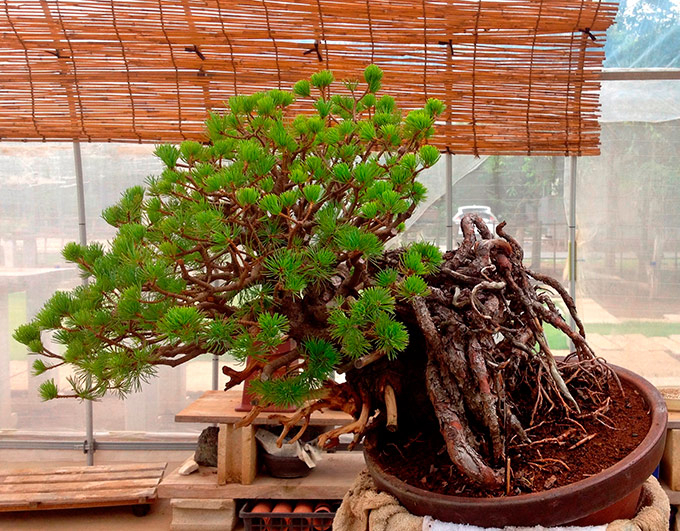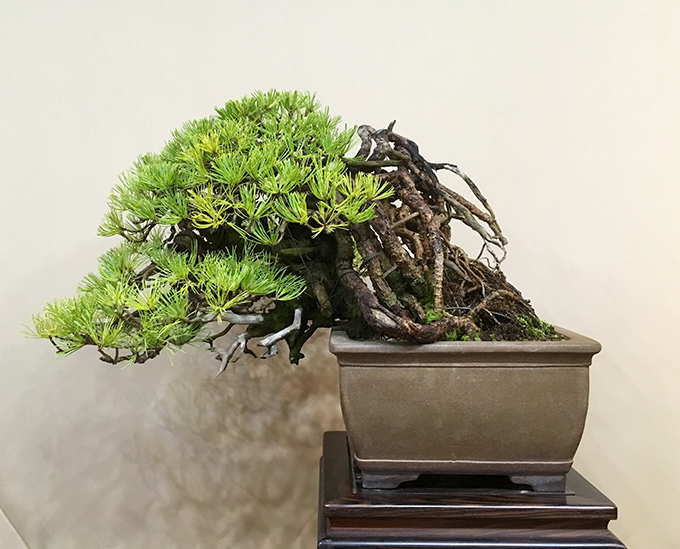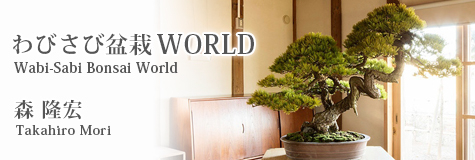
Vol. 3 Creation, Care, and Appreciation are the Three Joys of Bonsai
April is the time for replanting, and nipping buds from bonsai plants. For example, as new leaves begin to grow on a maple tree, two leaves will begin growing together, and then a third will start growing between them. This fresh bud is what I nip. Seeing the tree start to break buds is a moment of realization of the tree's powerful life force.
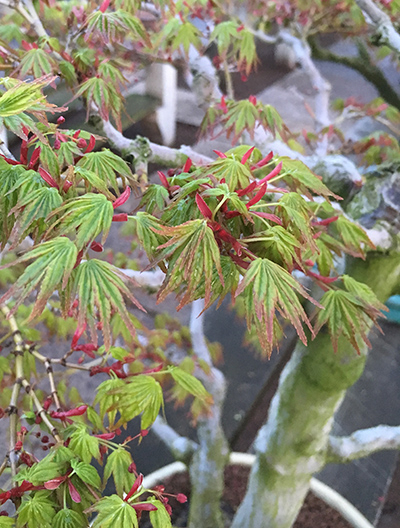
The fresh buds of the maple tree evoke a sense of spring.
At this time of the year, you may be getting tired of hearing about cherry blossoms, but allow me to share my recent cherry blossom viewing experience in Chidorigafuchi. It was actually difficult to walk because not only were there many visitors there to see the cherry blossoms, but there was also a university entrance ceremony being held at the nearby martial arts venue Nippon Budokan. Despite the crowd, we all still want to go cherry blossom viewing every spring. Perhaps it is simply part of the character of the Japanese people, part of our love for the four seasons.
While enjoying the blossoms, because of my occupation, I could not help but observe every aspect of the cherry trees, from the roots, trunk, and branches, to the state of maintenance. I start to create bonsai in my mind, imagining how I would prune the branches and trunks to add curves. My mind is just programmed to automatically think this way, even when I go hiking in the mountains or take a walk in the park.
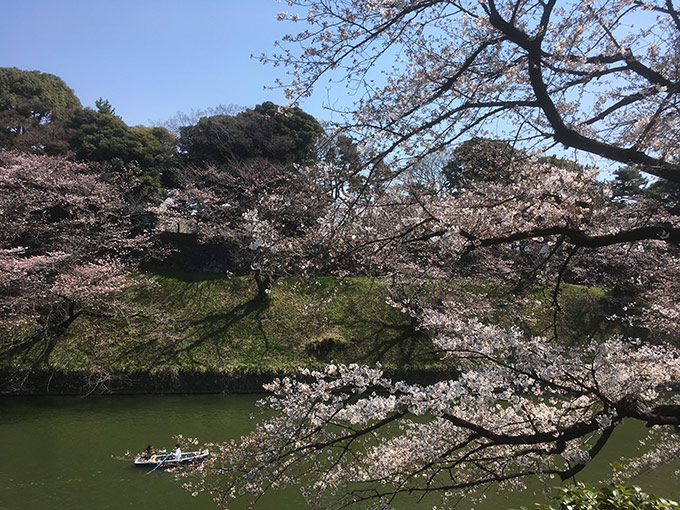
Creation, care, and appreciation -- these are the three great joys of bonsai.
While houseplants that are grown indoors provide the enjoyment of appreciating their unique leaves and shapes, bonsai also provides the enjoyment of shaping the plants as they change through the seasons. The act of creating involves choosing which side to call the front according to such visual elements as root spread, initial rise, the form of the trunk, and the placement of branches, and then pruning the plant and using wires to train the branches to alter the form.
This creation step is the main work which bonsai aficionados ask bonsai artists to do. You might wonder why the aficionados would ask someone else to handle the most enjoyable part of the process. In fact, bonsai artists possess the aesthetic sense and skill of a professional, and are thus able to guide the plant towards its ideal form in a shorter amount of time than an amateur.
Roughly 12 or 13 years ago, when I worked at a bonsai garden in Saitama Prefecture, I was never able to meet the demands of the job 100% due to my still limited adaptability at the time, and I struggled every day while working as hard as I could, gradually becoming drawn in to the depths of the bonsai art. Each day I would plan and conceptualize each new bonsai plant brought in, and train the branches with wire. This would be followed by a long discussion on bonsai with the master and other craftsmen. While it was a hard time, it was also a rich experience, and the valuable environment allowed me to lose myself in bonsai.
At one point, just when I felt I had made a bit of progress, I made the impudent move of asking a bonsai artist, far more advanced than I, to evaluate my work. His reply included a review of my very attitude towards the work itself.
He said, "If aficionados can guess who did the work, it means the one who created it is a second-rate artist. When they say 'I don't know who did it but it is done well,' then it means the artist has truly worked in a way that matches that particular tree."
In order to match a particular tree, we must leverage the uniqueness of that tree to the fullest. While this was something I was told incessantly during my years of training, the more experience I gained, the more my work would reflect my own personality.
If a bonsai plant embodies the personality of an artist, even slightly, then this will be apparent to viewers.
As a child of baby boomers that was constantly reminded of the importance of individuality, I would like to be able to say that a bit of personality showing up in my work should be fine. However, the fact of the matter is that it is the bonsai plant itself which is, in a sense, the lead actor, and the bonsai artist's job is to work as an invisible stagehand who cares for the plant for but a brief period in its long life so that it may be passed down to future generations.
The lifespan of the trees is much longer than people, thus the most important part of the job is to keep the trees alive and healthy. Thus, I ultimately came to the conclusion that the correct attitude for the bonsai artist was to work as an invisible stagehand.
Though describing the job as one of "creation" perhaps gives the impression that bonsai are man-made artifacts, bonsai trees will not necessarily grow the way one wishes no matter how one guides them.
Thus half of the work is done by the artist, and half by the plant itself.
Without the help of the bonsai plant, there can be no bonsai. Therefore, with nature's blessings of soil, water, light, and air, the artist's intent gradually fades over the many months and years, until the resulting bonsai plant is one that anyone would acknowledge as art.
To be honest, I feel that bonsai is moving in the opposite direction from today's society that emphasizes speed and digital technology. Bonsai can only approach completion through the application of great amounts of time, perseverance, and effort. We can be made aware of many ideas and realizations through interacting with bonsai in this way.
Incidentally, bonsai workshops are held in many places, so I invite you to attend a bonsai garden or event near you to experience the basics of bonsai for yourself.
My bonsai garden also holds fun beginner bonsai workshops every month, with lectures (and casual conversation sometimes) in the hopes that as many people as possible can experience bonsai.
The two-day workshop is the most I can do as an individual given my schedule, but I will do my best to make the time for it to hopefully increase the number of bonsai fans in the world.
Why don't you to start doing bonsai this spring?
【Information】
8th World Bonsai Convention in Saitama: April 27 through 30, 2017 at the Saitama Super Arena and other venues.
http://world-bonsai-saitama.jp/
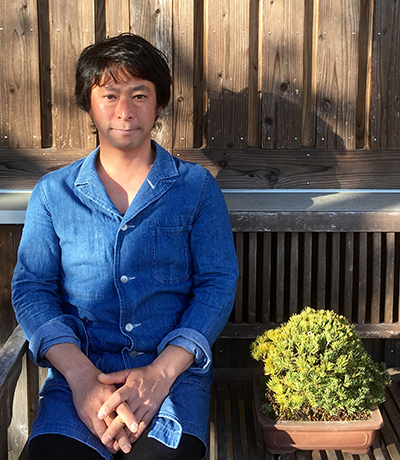 Takahiro Mori
Takahiro Mori
Bonsai master Takahiro Mori was born in Tokyo in 1979. After graduating from the College of Applied International Studies at Tokiwa University, in 2002 he began studying bonsai as an apprentice at Katsuta Koushouen, a bonsai garden in Ibaraki Prefecture. In 2006, he became independent and launched his own activities. In 2009, one of his works won the Kokufu Award at the Kokufu-ten Bonsai Exhibition, an event with a long and distinguished history. From 2009 to 2013, he worked as an in-house bonsai artist at the Omiya Bonsai Art Museum, Saitama. In 2013, he traveled to Kosice in Slovenia, the European Capital of Culture 2013, as a bonsai demonstrator, and participated as a representative of bonsai masters in the presentation for Saitama's bidding to host the 8th World Bonsai Convention, which will be held in 2017. Mori conducted demonstrations at Bonsai Slovakia 2014, and participated as a bonsai expert in the Japan Government exhibit at the EXPO 2016 Antalya International Horticultural Exposition held in Turkey in 2016. Today, in addition to his work as a bonsai master, Mori is actively engaged in initiatives to promote the art of bonsai in Japan and abroad through workshops for beginners that he conducts at his atelier Bonsai Mori established in 2013 and bonsai classes he organizes in California in the United States.
Bonsai Mori website:http://bonsaimori.jp/
Bonsai Mori Facebook page:https://www.facebook.com/Bonsaimori/
Related Articles
Keywords
Back Issues
- 2022.7.27 Beyond Disasters - T…
- 2022.6.20 Beyond Disasters - T…
- 2021.6. 7 Contributed Article …
- 2021.4.28 Crossing Borders, En…
- 2021.4.27 Contributed Article …
- 2021.4.20 Contributed Article …
- 2021.3.29 Contributed Article …
- 2020.12.22 Interview with the R…
- 2020.12.21 Interview with the R…
- 2020.11.13 Interview with the R…


